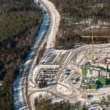Improved regulation has been good for the nuclear industry and public safety
By Andrew C. Kadak, June 21, 2008
We have not yet discussed how U.S. utilities dramatically improved the performance of their nuclear plants in the last 10 years, and the role, if any, the Nuclear Regulatory Commission (NRC) played in this improvement.
As a result of performance gains and approved power uprates in the last decade, the equivalent of 20 large, 1,000-megawatt plants was added to the grid. Capacity factors, which are measures of the relative output of power plants, have risen dramatically from a low 70-percent fleet average to more than a 90-percent fleet average, essentially maximum capacity.
This improved performance occurred during a time of transition at the NRC, when it began to focus on performance-based and risk-informed regulation and enforcement. By focusing on the key safety issues, the NRC gave utilities more time to concentrate on the day-to-day business of operating and maintaining nuclear power plants and enhancing their performance. With the onset of energy deregulation, plants were forced to improve performance further, since their earnings were based on keeping their generation costs low and not guaranteed by regulated rates. Today, a significant percentage of U.S. nuclear plants are deregulated “merchant” plants that sell electricity to the grid based on market prices. For these plants, capital, operating, and fuel costs must be recovered at a price the market will pay. Thus, there’s tremendous pressure to make their operations even more efficient.
Deregulation concerned the NRC because it feared the utilities would focus more on reducing costs than on maintaining plant safety. The lesson learned from the experience–both in economic and safety terms–is that a well-maintained and well-operated nuclear plant is a safe and profitable plant. Utilities have learned this lesson, sometimes the hard way; however, the pressure between safety and commercial interests is still a real concern. At present, most utilities, with some exceptions, have come down in favor of increased safety.
Utilities are well aware of their obligations–not only to shareholders and consumers, but also to the rest of the industry whose reputation would suffer from poor and unsafe performance at individual nuclear plants. If the existing fleet wasn’t performing as well as it does and not generating substantial revenue for owners, the 30 new U.S. reactors and 8 license applications already filed with the NRC wouldn’t have recently been announced.
The confidence expressed by the industry in nuclear power is largely based on the outstanding performance levels of the fleet. While new plants will be very costly, the judgment of many nuclear energy companies is that over the long-term, nuclear power will provide them and their customers with the only chance for stable electricity rates. And if carbon emissions are to be priced in the future, the attractiveness of nuclear power will be even greater. Of course, the continuing challenge is to vigilantly keep plants maintained and operated with safety in mind. The NRC’s focus on a risk-informed, performance-based regulatory system has allowed the industry to strike that needed balance between safety and economic performance.
Topics: Nuclear Energy
Share: [addthis tool="addthis_inline_share_toolbox"]














